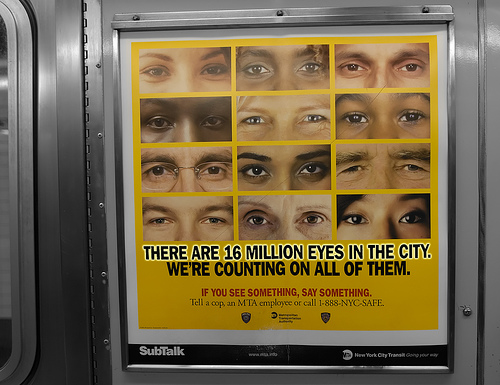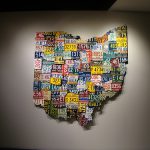Study: Media distortion affects perceptions of transit safety
Public transit disasters may make for splashier headlines than car crashes, but in reality riding public transit is much safer than traveling by car — and the implications for community safety are enormous. A study from Todd Litman at the Victoria Transport Policy Institute reveals just how safe, and the estimates are startling: Bus riders are 60 times safer than those riding in a car; commuter or intercity rail riders are about 20 times safer than in a car, and metro or light rail riders are around 30 times safer.

Todd Litman thinks vague instructions like New York City’s “If you see something, say something” may do more harm than good by driving potential users away from transit. Image from CarbonNYC.
(Check out this helpful graph for a comparison on fatalities among intercity bus, heavy rail, transit bus, commuter rail, passenger car, light truck, and heavy truck ridership. One compelling example: Car or light truck driver or passenger travel averages 7.28 deaths per billion passenger-miles. Compare that to bus travel, whether transit, intercity, school or charter buses, which has results in just 0.11 deaths per billion passenger-miles.)
Transit travel impacts community safety at large, too, reports Litman: Transit travel “has about 1/10 the traffic casualty (injury or death) rate as automobile travel, and residents of transit-oriented communities have about 1/5 the per capita crash casualty rate as in automobile-oriented communities [sic].” Transit also usually involves less crime than auto travel, and improving public transit “can help reduce overall crime risk by improving surveillance and economic opportunities for at-risk populations.”
Yet many communities are hesitant to expand their public transit networks because of largely unfounded fears of danger, attributable to disparaging media coverage, perceived threats of terrorism, and worries about violence, especially in poor communities. Knowing the facts, particularly those Litman draws out in the report, can help communities understand just how safe public transit can be — and already is.
Most fears are ungrounded, the survey reveals. The actual magnitude of transit passenger crash risk is very low — lower than automobile travel — but “although infrequent, transit crashes receive heavy media coverage, which exacerbates fear.” Litman’s proposed narrative? “Emphasize overall safety of transit travel and ways to further increase this safety.” Or consider another type of risk: crash risk while accessing transit. “Walking and cycling have relatively high crash rates per mile/km, but per-capita crashes tend to decline with increased use of these modes.” Because these types of crashes also get top billing in terms of media coverage, the best way to create a new narrative is to “Acknowledge this risk and describe practical ways that individuals and communities can reduce it.”
Consider terrorism threats, a top concern for many and a major feature on any nightly news show. Though the relative risk is quite low, highly publicized acts, like the attacks on Madrid and London’s transit systems, increase riders’ and potential riders’ fears. Yet the likelihood of being involved in a car crash is much higher: In 29 countries, points out Litman, “between 1994 and 2003 traffic deaths were approximately 390 times that of international terrorism.” Transit agencies’ campaigns don’t always address the realities behind these figures, either; New York City’s transit system promotes the cryptic “If you see something, say something” tagline, which can “unintentionally increase fear with safety and security messages that emphasize dangers, including dramatic but unlikely threats such as terrorism.”
If they can move beyond their fears, communities would benefit economically from creating or increasing public transit through increased job opportunities as well as decreased auto-related costs. Programs and policies that address high-risk driving (drunk driving, for example), argues Litman, can be made even more efficient by implementing transit improvements — like increased service, “nicer vehicles and stations,” amenities, and improved user information — for example. These improvements result over time in reduced transit vehicle crash rates, reduced vehicle travel, and, eventually, reduced total per capita crash casualties and costs.
Expanding efficient and safe public transit systems depends on fact-checking the story that the rider — or would-be rider — hears. Transit officials, advocates and everyday aficionados alike can learn more about how to develop a new transit safety narrative online by checking out Litman’s full report.
Related Posts
Category: Miscellaneous, Transportation

















